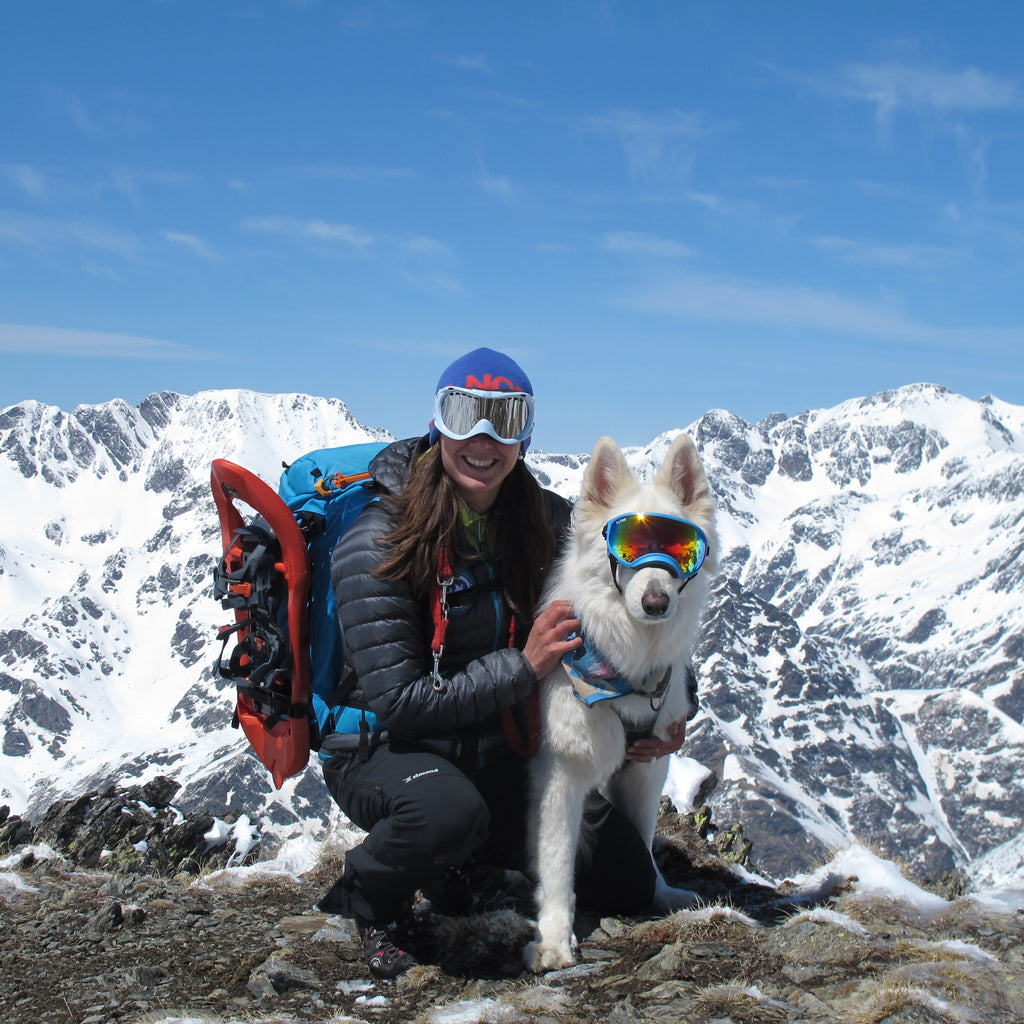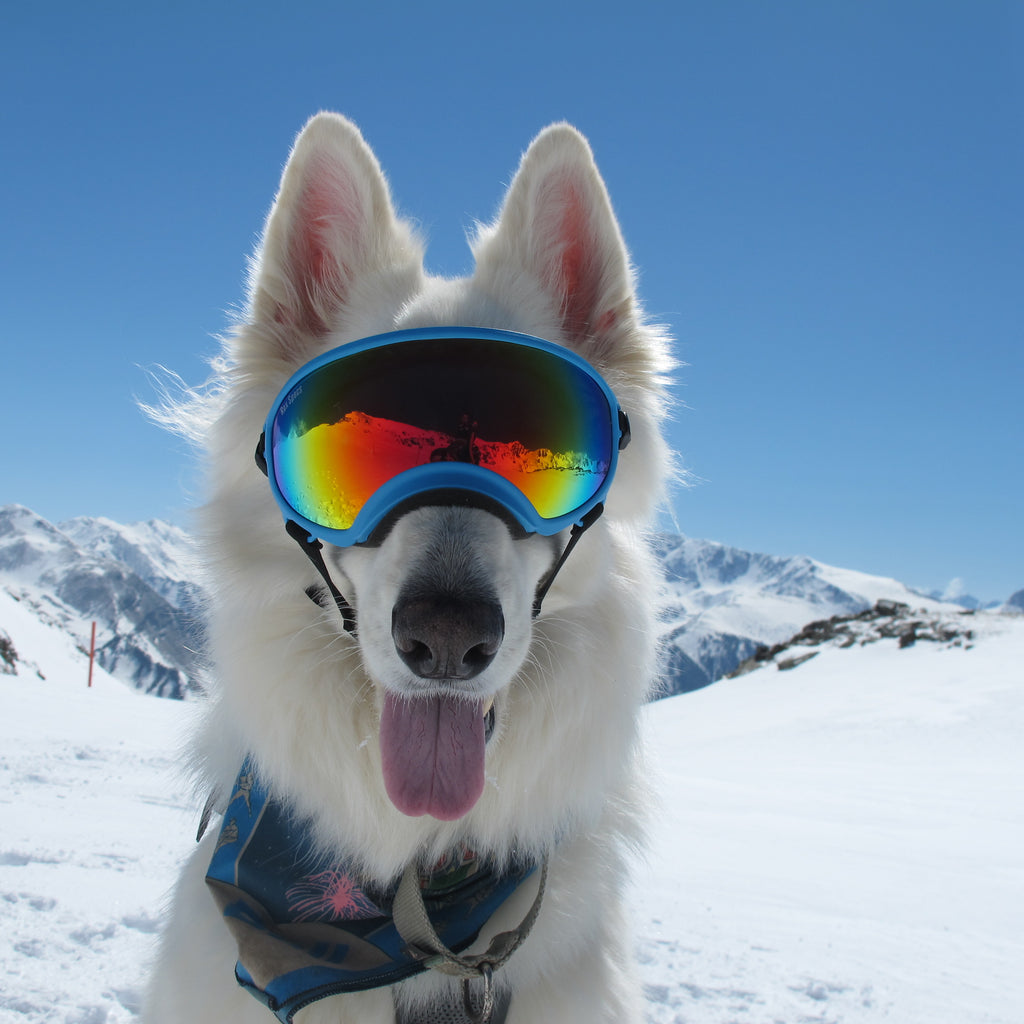Dakota is one of our Rex Specs Ambassadors, a 5-year-old White Swiss shepard, along with her human counterparts, Sergio and Bea. All three love to spend time in the mountains trekking and mountaineering all over the world. Dakota has visited glaciers in Argentina, reached summits in the Central Pyrenees and trekked countless miles through peaks in Europe. You can follow all of her adventures at www.dakotassummits.com. In the meantime, Sergio and Bea posted a blog about the effects of UV exposure to dogs, and we're excited to provide a translation of the post on our blog! This is a translation (Google translate) of the the post found on Dakota Summits website.
Does My Dog Need UV Protection if We Live in the Mountains?
By Beatriz Gazeau / Dakota's Summits
We're outside in the mountains with our dogs for long adventures where they're exposed to the sun and other harsh weather conditions like rain, wind and blizzards. Concerned that the UV rays at higher altitudes might be affecting our dogs, we began combing the internet for articles or other information on the subject. What we found instead was a lack of information, and when information did exist it wasn't all that clear, leaving us with a lot of questions.
So we decided to contact the Veterinary Institute of Oftalmolófico (IVO) in Barcelona to interview Dr. Francisco Simó. To give you some background on Dr. Simó, this is excerpted from http://ivoft.com:
"Dr. Francisco Simó graduated from the University of Zaragoza in 1986 in Veterinary Medicine. From the beginning of his career, he had a passion for ophthalmology, completing his training with a postgraduate diploma in ophthalmology at the University of Barcelona and the Toulouse Veterinary School (CES). He has completed residencies at the Faculty of Veterinary Medicine of Toulouse, with Dr. Marc Simon in Paris and at the Ophthalmology Service of Long Island Veterinary Specialists of New York. Since 1990, he has concentrated in the microsurgery of the anterior segment of the eye. He was the first veterinarian in Catalonia to perform cataract surgery by Phacoemulsification and also the first to place an intraocular lens into a dog."
We reached out to Dr. Simó, who was delighted to answer our questions.
Are UV rays harmful to our dogs?
UV rays are only harmful to dogs who already have an eye disease or are prone to allergies. These especially include pathologies of the cornea, such as pannus, but can also include "Dry Eye," eye tumors and cataracts. Though we don't have proof of this yet, we suspect problems with the retina could also be adversely affected. The clearest case where the disease progresses faster through environmental conditions -- particularly UV radiation -- is pannus, which most commonly affects German shepards.
Also, some cases of tumors such as squamons cell carcinomas and hemangiomas may worsen by UV exposure or even begin as a result of excessive sun exposure.
To what extent does UV light affect dogs?
In cases of dogs with the diseases described, or where there's a genetic predisposition to allergies, sun exposure worsens symptoms and makes treatment difficult. With pannus specifically, it becomes a very difficult problem to treat and control.
What causes these diseases? Are they created by injury?
Dogs and animals in general never look directly at the sun -- they will always try to turn their head, so the sun rays themselves don't actually create injury. But the UV rays can further harm an animal who is already more inclined to the the disease either based on their breed or genetic predisposition. So in those cases, if you live in places that have more UV exposure (like mountains, snowy areas or beach areas), the dog's condition will suffer from UV exposure, making their symptoms worse and treatment difficult.
Is vision affected by the cold, snow, wind or rain in the mountains?
Cold does not affect vision, but wind can cause problems such as dry eye syndrome in dogs who have genetics for bulging eyes or broad, short skulls (like bulldogs and pugs). Eye allergies tend to worsen with the wind and sun. Snow is similar to the sea in that it increases UV exposure, which can worsen the conditions of dogs who are suffering from certain eye problems.
Is the risk of eye injury heightened at higher altitudes?
As with the snow and the sea, higher altitude means more UV exposure, and therefore more risk of worsening an eye problem related to sun exposure.
What preventative measures should be taken to avoid eye injuries in our dogs?
We don't need to worry about sun exposure of healthy dogs any more than we do in the case of people. The only difference is that we (people) wear sunglasses to protect our eyes and to avoid discomfort, but in dogs this is more complicated. But now we're seeing eye protection come out for dogs as well, and some of them are well tolerated.
It's advisable to keep the sun off predisposed animals, and if that's not possible, try to avoid excess sun exposure by keeping them away from the snow and the beach, especially in the summer.
What do you think of canine protective eye wear? Do you think they are a good preventative measure?
Canine protective eye wear is a very good preventative measure, just like for people. It's ideal to use them, especially for dogs with eye diseases such as pannus, dry eye or lighter-skinned animals.
In conclusion, according to Dr. Simó, dogs with eye diseases and dogs with genetic predisposition, should wear UV protective eye wear to prevent injury.
All photos by Dakota's Summits.



